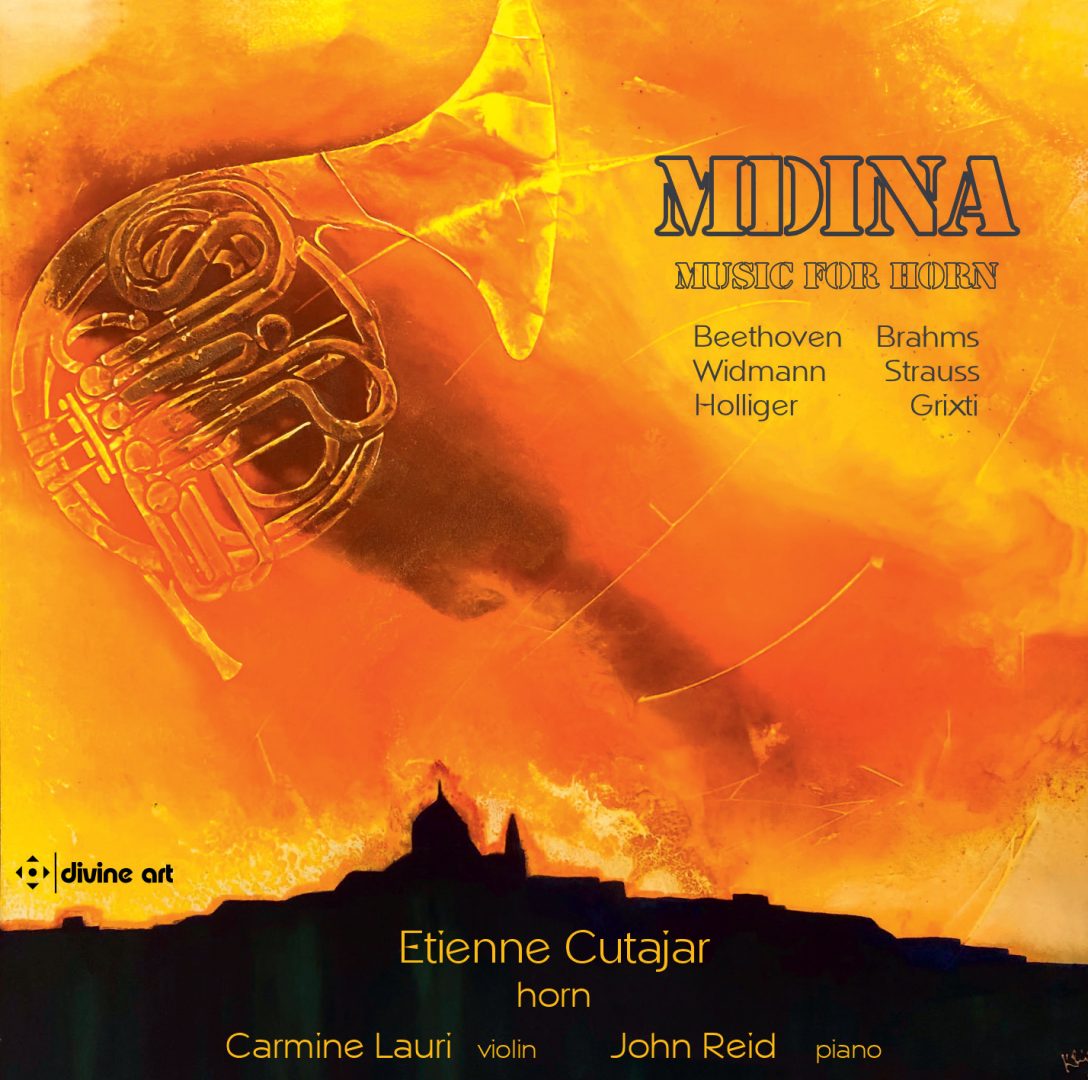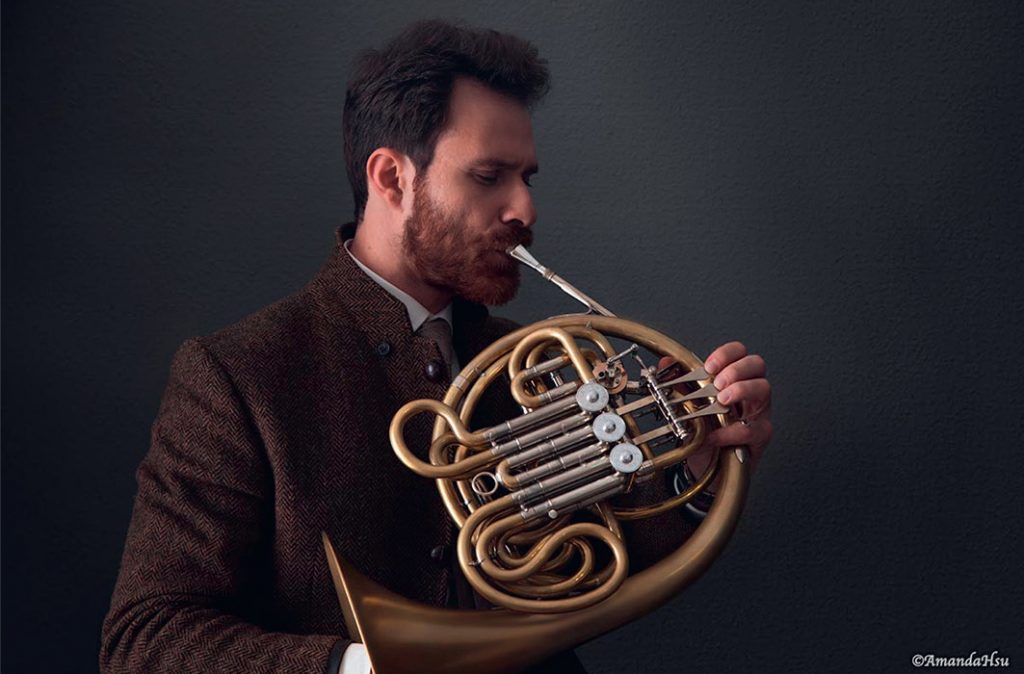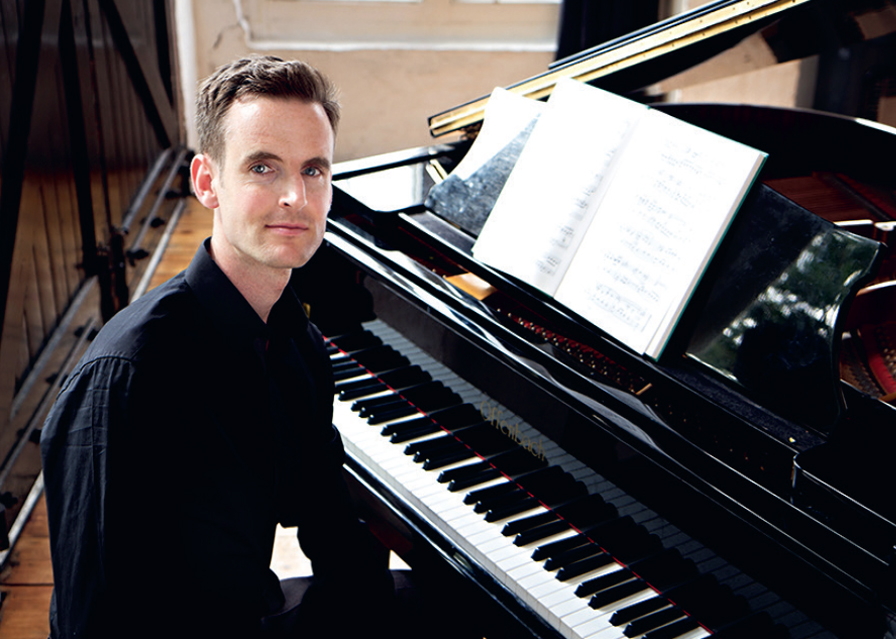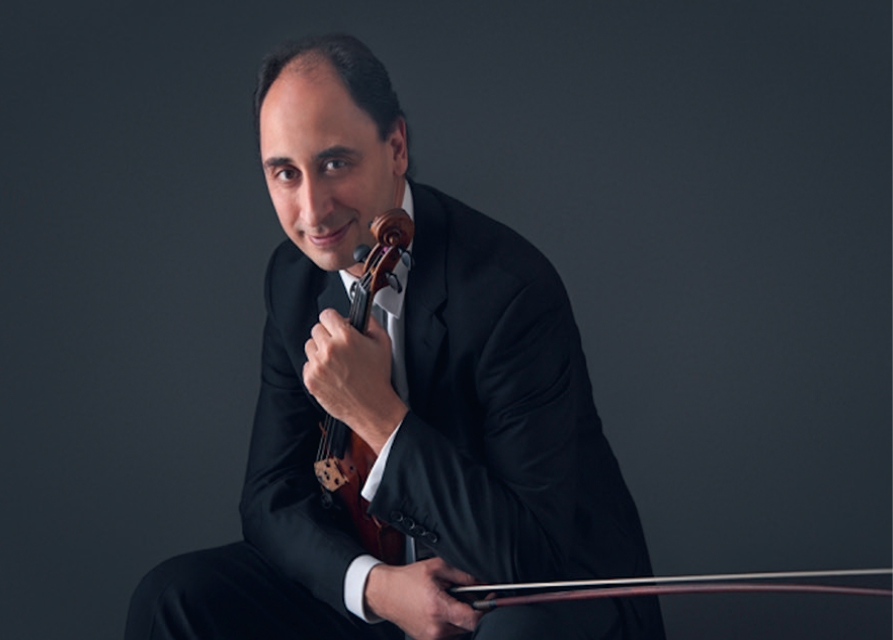The Music
The horn has been a standard member of the orchestra since the early 18th Century. Composers were attracted to its beautiful sound and versatility: its call could be bright and rousing, reminding one of the horn’s origin as a “hunting instrument”, but it could also be gentle and lyrical. A ‘classical’ orchestra, such as the one required for the symphonies of Mozart and Haydn, generally had parts for two horns but, in the increasingly large orchestras of the Romantic period, four to eight horns became the norm. It might therefore come as a surprise that, whilst the horn cemented its place in the orchestra, relatively few of the really great composers seemed interested in writing solo, concertante or chamber works for the instrument (when compared, for instance, to the violin).
Most of the horn concertos of the 18th and 19th century were virtuosic, exhibitionist pieces by minor composers – often horn players themselves. The reason for this is probably a technical one. After the invention of the valved horn in the 19th century, horn players prefered to perform on the natural horn, which meant that still only a few notes of the major scale could be easily produced, with others sounding out of tune (depending on the “Harmonic Series”). Only a handful of virtuosi of the instrument could play all the notes of the scale, that is, by altering the hand position in the bell-flare accordingly, thus creating a “stopped” sound simultaneously. It made little sense to write a challenging piece for horn without a readily available and competent performer. Mozart, for instance, did write four concertos, but they were all meant for the Mozarts’ close family friend Joseph Leutgeb, a cheese merchant who, when not behind a dairy-product counter partly financed by Wolfgang’s father Leopold, excelled as a leading hornist of his age.
Similarly, Ludwig van Beethoven (1770-1827) composed his Sonata in F Major for Horn and Piano, Op. 17 in 1880 upon a commission by Czech hornist Johann Wenzel Stich (1746-1803), better known by the pseudonym Giovanni Punto. Punto was not only the most famous virtuoso of the day, but also one of the pioneers of the stopped-note technique. Beethoven tailored his sonata for Punto’s extraordinary capabilities and performed it with him at its premiere at the Kärntnertortheater in Vienna, and in several other public and private concerts after that –in fact, whilst the ‘star’ may be the horn soloist, the piano part is also elaborate and well-written. The work follows a three-movement structure. It starts with an Allegro moderato [1], built upon two contrasting themes which, in line with the typical ‘sonata form’, are first presented, then playfully explored and developed, before a return to the opening material. This first movement is remarkable for its dialogue between the two instruments – the piano comes across as an equal in a musical conversation. The second movement – Poco adagio, quasi andante [2] – provides a moment of calm respite before the concluding Rondo: Allegro moderato [3]. The horn is taken through its paces in a number of varied episodes, including a brief, melancholic passage in the minor key, leading to a bright and triumphant conclusion.
By the mid-19th Century, the valved horn, with its additional technical possibilities, had all but replaced the natural horn. Interestingly, however, Johannes Brahms (1833-1897) opted for the latter instrument in his Horn Trio in E-Flat Major, Op. 40. Brahms wrote the work in 1865, the year in which his mother Christiane passed away, and the trio – which is partly a memorial to her – is imbued with a sense of nostalgia. This might have been the reason behind Brahms’s preference for the more archaic natural horn. Also relevant is the fact that Brahms started conceiving the piece during a spring vacation at Baden in the Black Forest – the particular timbre and sylvan associations of the natural horn might have seemed to him more attuned to these natural surroundings.
The trio, written for the unusual combination of violin, horn and piano (three instruments which Brahms had played in his youth), is also unconventional in its structure. It has four, rather than three movements, and like the Baroque sonata da chiesa starts with an extended slow movement – a leisurely Andante [8] in which the melody instruments amiably exchange lyrical passages over a rather sombre piano accompaniment. The ensuing Scherzo (Allegro) [9] is appropriately playful and energetic, with the horn coming into the fore with its ‘hunting calls’ and the violin and piano joining in with sparkling responses.
MUSIC FOR HORN
Ludwig van BEETHOVEN (1770-1827)
Sonata for Horn and Piano in F major, op. 17 (1800) [14:47]
Jörg WIDMANN (b. 1973)
Air für Horn (2005) [9:38]
Richard STRAUSS (1864-1949)
Andante for Horn and Piano, op. 86a (1888) [4:22]
Jesmond GRIXTI (b. 1969)
Mdina (1995) [6:43]
Heinz HOLLIGER (b. 1939)
Cynddaredd-Brenddwyd (2001, rev.2004) [8:07]
Johannes BRAHMS (1833-1897)
Horn Trio in E flat major, op. 40 (1865) [28:29]
Etienne Cutajar (horn), Carmine Lauri (violin), John Reid (piano)
rec. 2017, Potton Hall, Suffolk, England
DIVINE ART DDA25189 [72:28]

The trio section is calmer and hints at darker memories – it is based on material from a short unpublished piano piece which Brahms had written twelve years earlier. Whilst high spirits are restored in the conclusion of the Scherzo, we soon realise that the trio was preparing us for the heartbreaking third movement [10]. Marked Adagio mesto (‘slow and sorrowful’), even this tempo indication alone indicates the depths of melancholy which will be plumbed. A sense of mourning is created by the deep, rolling chords in the piano and the elegiaic themes of the horn and violin. As the movement concludes, the horn slowly intones a chorale-like German folk melody entitled In der Weiden steht ein Haus (“In the Meadows Stands a House”), a song which Brahms would have known and sung in his childhood. Miraculously, the same melody returns, transformed, as the principal theme of the life-affirming Finale: Allegro con brio [11], dispelling the heavy atmosphere and restoring a feeling of hope.
The horn also had a very personal meaning for the great composer and conductor Richard Strauss (1864-1949). Richard’s father (and earliest mentor) Franz was a leading horn-player who was even consulted by Wagner in the preparation of the horn parts for his operas. Strauss wrote a number of works dedicated to Franz, including an Andante for Horn and Piano in C major, op. 86A [5].
Contemporary composers remain intrigued by the instrument and its characteristics. Some have taken up the additional challenge of writing not just solo, but unaccompanied works for the horn. By removing the support of a ‘harmony’ instrument such as the pianoforte, composers bring the horn’s sound qualities to the fore, exploting the instrument’s centuries-old traditions and associations and expanding them through innovative techniques. A case in point is Mdina [6] by the Australia-based Maltese composer Jesmond Grixti (b. 1969).
This work, which Grixti has also arranged for trombone, was written whilst the composer studying with Franco Donatoni in Italy, and it was premiered in 1995 by Alessandro Lando, then horn player at Venice’s Teatro La Fenice. Acclaimed by The Melbourne Age as “a stand-out work”, its title suggests that it is a musical portrait of Malta’s medieval “Silent City”. The composer himself has described his piece as having “a solid structure built on gestural clarity, mirrored-intervallic relationship, organic progression and solo virtuosic writing”. It has a three-part structure – to quote the composer, “[it] starts with a pungent energico con fuoco tempo, which is full of verve and masculinity, followed by a beautiful lyrical moment which portrays the soft side of the horn, bringing out the southern Mediterranean passionate soul. The piece unveils in time until it reaches a climactic momentum that progressively resolves to a quiet ending”.
Heinz Holliger (b. 1939) is a Swiss oboist, composer and conductor. His Cynddaredd – Brenddwyd (Gaelic for “rage – dream”) [7] was originally an episode in his intriguingly-titled COncErto…? Certo! – cOn soli pEr tutti written in 2001 for the Chamber Orchestra of Europe (COE). Holliger revised it as a ‘free recitative’ for unaccompanied horn in 2004, dedicating it to Jonathan Williams, former horn player of the Chamber Orcehstra of Europe and the BBC Symphony Orchestra. It is a brief but highly demanding work, which explores the contrasting moods implied by its title through various extended techniques including trills, half-pressed keys, ‘flutter-tonguing” and passages requiring simultaneous blowing and singing into the instrument. Yet, the composer manages to rein in the work, so that it does not become a mere panoply of special effects.
Like Holliger, German composer Jörg Widmann (b. 1973) is also an acclaimed instrumentalist (in Widmann’s case, a clarinettist) with an intimate knowledge of the classical repertoire. Indeed, his works are notable for the way in which they reinterpret the traditions of the past, as in his Hunt Quartet which uses elements from Beethoven’s Seventh Symphony. This approach is also evident in his 2005 work “Air” for unaccompanied horn [4]. “In my solo works during the past few years, I have attempted to find out something about the character of each instrument portrayed”, the composer tells us in his programme note for his piece.
“Air’ is no less virtuosic in its technical playing characteristics, but the work is as a whole orientated towards a simple vocal gesture – “air” in both its literal meaning and as the established melodic term”. In a reference to the precursor of the modern instrument, the “natural horn”, Widmann makes use of the horn’s harmonic series and fluctuates between open and stopped notes creating “a natural work on the themes of proximity and distance”. Thus, in a dialogue with the past, the horn repertoire keeps reinventing itself.
This posthumously published work was composed in 1888 for the occasion of the silver wedding anniversary of Richard Strauss’s parents and it seems that, at some point, the composer was planning to include it as a movement in a never completed horn sonata. Perhaps as a reflection of “Papa Franz”’s conservative tastes, this work is fairly conventional in its harmonies, although some surprising key changes hint at the trailblazing composer which Richard would soon become.
The Musicians
Born in 1983, Etienne Cutajar is a native of Malta and took up horn aged ten at the local band club and under the tuition of Raymond Cremona, Emanuel Spagnol and Paul Borġ. Etienne became third Horn of then the National Orchestra of Malta aged eighteen. He gave up this post after two years in order to pursue a full-time postgraduate course at the Royal Academy of Music, fully funded by the ABRSM. Etienne is nowadays an “Associate of the Royal Academy of Music” and is also a pupil of Fergus McWilliam and Markus Maskuniitty.
For two consecutive years Etienne was principal horn player of the European Union Youth Orchestra under the conductorship of Bernard Haitink, Sir Colin Davies and Vladimir Ashkenazy. Over the years he has also guested as principal horn with some of the finest orchestras and performing groups of Great Britain as well as internationally, such as with the Royal Stockholm Philharmonic Orchestra, Seoul Philharmonic Orchestra and Orquestra Sinfónica do Porto at Casa da Música. In 2006 Etienne was appointed associate principal horn of the BBC Scottish Symphony Orchestra, which position he kept and treasured for ten years. In 2016 he gave up this post in order to return to his homeland and to take up the position of Principal Horn of the Malta Philharmonic Orchestra.
As a soloist Etienne appeared at the Purcell Room and Wigmore Hall, at some of the finest venues in Malta as well as a few more in central Europe. During the Edinburgh International Festival of 2006, Etienne took a solo part in Schumann’s Konzertstück for 4 horns – accompanied by the BBC Scottish Symphony Orchestra. Later that year he recorded Bach’s Brandenburg Concerto No. 1 with Trevor Pinnock at the purposely-formed European Brandenburg Ensemble. Etienne has also performed for several times both of the Strauss concertos with the Malta Philharmonic Orchestra, ‘Orchestre-Atelier Ostinato’ of Paris and the Armenian State Symphony Orchestra. In 2007 he released his solo album ‘Fantasie’ on Divine Art, which album features the ‘Fantasie Sonata for Horn and Piano’ dedicated to him by his compatriot and dear composer friend Charles Camilleri. Etienne is also a founder member of ‘Carnyx Brass’.
In his free time Etienne enjoys long country walks, rock climbing, swimming, a warm climate, hanging around relatives and friends, and the local cuisine that he sometimes cooks.
John Reid‘s career to date has shown him to be a pianist of notable versatility and range, with wide experience as an outstanding chamber musician, song accompanist, soloist and exponent of new music. In November 2017, he made his concerto debut in Germany with the Deutsche Philharmonie Merck (Brahms No. 1) and he continues his collaboration with Aurora Orchestra, both as principal pianist and as a soloist in a series of the complete Mozart concertos at Kings Place in London.
Much in demand as a guest pianist with a number of other leading ensembles, he has performed recently with Birmingham Contemporary Music Group, London Conchord Ensemble, Archangelo, London Haydn Project (Mozart concertos K.271, K.595 and K.453) and The Sixteen (a Schumann and Brahms series in London, Manchester and Bruges). He was invited to programme a concert series for the Britten centenary at Kings Place, which incorporated new works by Simon Holt, Jonathan Dove and Martin Suckling; and he has performed regularly in recent seasons at The Sage Gateshead, both as a guest of the Royal Northern Sinfonia chamber music programme and as a Samling Artist.
Over the course of fifteen years, John has partnered many of the UK’s leading singers and instrumentalists. During the 2017-18 season, he gives recitals with violinist Mathilde Milwidsky, violist Timothy Ridout and trumpeter Matilda Lloyd. A parallel interest in cross-arts collaboration has led to concerts with Poet in the City, the writer John Hegley, the flamenco dance group Dot Dot Dot (in the first performances of Los Nacimientos by Tom Randle at the 2017 Buxton Festival) and the artist Will Lindley.
Recordings include trios with the Emanuel Ensemble (Champs Hill Records) and premiere recordings of music by Emily Hall (Befalling, with Oliver Coates and Mara Carlyle), York Bowen (works for two pianos, with Michael Dussek for Dutton Epoch), Clifford Benson and Rhian Samuel. He has recorded numerous times for BBC Radio 3.
John Reid studied at Clare College, Cambridge and at the Royal Academy of Music with Michael Dussek. His teachers have also included Christine Croshaw, Malcolm Martineau and Rudolf Jansen. He was a recipient of the 2004 Gerald Moore Award and the 2003 Kathleen Ferrier and Maggie Teyte Pianist Prizes, and he is now an Associate of the RAM. Increasingly in demand as a teacher, he is a Professor at the RAM and he coaches ensemble performance at Goldsmiths College.
Carmine Lauri was born in 1971 and started playing the violin at the age of four.In 1988 he was awarded the Associated Board scholarship to further his studies in London at the Royal Academy of Music with Maurice Hasson and other distinguished artists including Anne Sophie Mutter & Ida Haendel.
Lauri has performed extensively worldwide including performances in the presence of HM Queen Elizabeth II and other Heads of State. Since the year 2000 he has beeen Co-Leader of the Concertmaster of the Oxford Philharmonic and Guest Leader of the Malta Philharmonic Orchestra. He has also been guest concertmaster of various orchestras including the Academy of St Martin in the Fields, the Orchestra of the Royal Opera House Covent Garden, the London Philharmonic, the Rotterdam Philharmonic, the Bournemouth Symphony, Manchester Camerata and the Hong Kong Philharmonic Orchestra under distinguished conductors such as Lorin Maazel, Bernard Haitink, Sir Colin Davis, Sir Antonio Pappano, Riccardo Chailly, Pierre Boulez, Valery Gergiev and many others.



Carmine regularly leads the London Symphony Orchestra and has led the orchestra in numerous recordings including music scores of several movies, including Star Wars, Harry Potter, The Queen, The Danish Girl, Suffragette and is often the featured violin soloist in many films such as ‘As you like it’ and ‘Joyeux Nöel’.
Throughout his career Carmine has performed concertos with many international orchestras including the LSO, LPO, the Czech Philharmonic and Czech State Phil of Brno, the Oxford Philharmonic, the Orquesta Municipal de Caracas, and the Malta Philharmonic Orchestra. He has also premiered two violin concertos with the LSO. Carmine is regularly invited to judge final rounds of music competitions held in London and to coach advanced students at the Royal Academy of Music and the Guildhall School of Music and Drama. He also regularly coaches students at the Royal Academy of Music as part of their orchestral training and conducts sectional string rehearsals to prepare the orchestra for their concerts.
In 2004 and 2006 respectively, Carmine was elected as Associate of the Royal Academy of Music (ARAM) and Fellow of the Royal Academy (FRAM) for his achievements in his career. Carmine currently plays a violin by Nicholas Lupot made in ca 1780. Carmine’s distinguished talents were acknowledged by his country which bestowed upon him the National Order of Merit – M.O.M. (Ġieħ ir-Repubblika).
Most recent performances have included performances of Wieniawski’s 1st Violin Concerto, the Bruch Violin Concerto, a number of solo performances accompanied the LSO including a joint duo performance of Monti’s Czardas with the world famous Roby Lakatos.
He recently directed and performed with the Baltic Neopolis Orchestra as part of their Great Concertmaster series in Poland. Last November Carmine was invited to give a recital at the Frankfurt Opera as part of the Malta Culture celebrations in Germany. Future performances include a performance of Vivaldi’s Four Seasons in Malta and Bottesini’s Grand Duo with the Oxford Philharmonic.
Carmine Lauri has two solo compact disc recordings to his credit, Bravura (1994) and Violin Extravaganza (2004).
